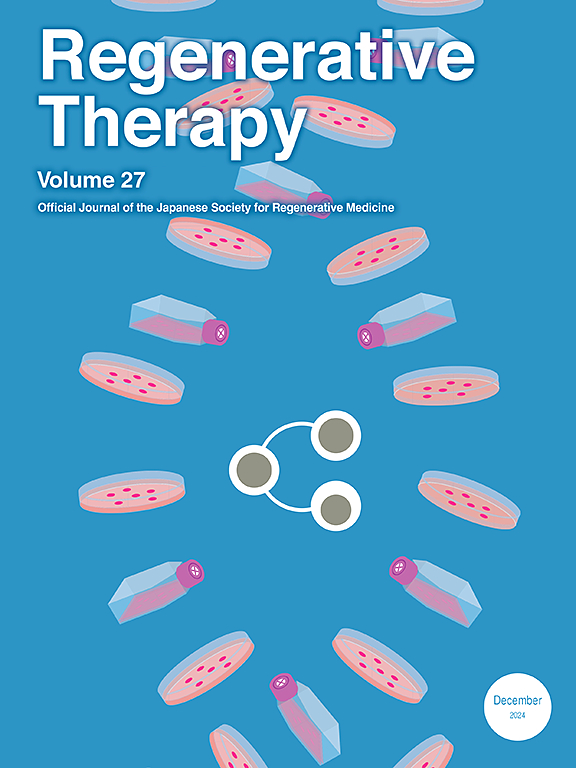Resolve D1 promotions the repair of cornal epidemiological damage in diabetes by regulating epidemiological response and oxidative stress
IF 3.5
3区 环境科学与生态学
Q3 CELL & TISSUE ENGINEERING
引用次数: 0
Abstract
Objective
It aimed to thoroughly analyze the promotive outcome of Resolvin D1 (RvD1) on the repair of corneal epithelium (CE) damage in diabetes mellitus (DM) mice and its molecular mechanisms.
Methods
27 male C57BL/6J mice were selected. Type 1 diabetes mellitus(T1DM) mice models were prepared by streptozotocin (STZ) intraperitoneal injection (IPI), and central CE scraping was performed on all mice. They were grouped: Group S1 (S1G, RvD1 treatment), Group S2 (S2G, DM mice), and Group D0 (D0G, normal mice). The CE defect area and sensitivity, the expression of CE regeneration pathway-related factors and oxidative stress (OS) indicators, and the expression of antioxidant genes, inflammatory-related factors were compared.
Results
As against S2G, in D0G and S1G, the corneal defect area was visibly smaller at 1, 2, and 3 d post-surgery, and the corneal sensitivity was consistently greater from 1 to 9 d; The content of p-EGFR, Sirt1, Ki67, GSH, Nrf2, MnSOD, NQO-1, and HO-1 in the CE in D0G and S1G was visibly greater as against S2G; As against S2G, in the CE in D0G and S1G, the activity of myeloperoxidase (MPO), the concentration of tumor necrosis factor-alpha (TNF-α), and interleukin-1 beta (IL-1β) were visibly lower, and the content of reactive oxygen species (ROS), NOX-2, and NOX-4 was visibly smaller (P < 0.05).
Conclusion
RvD1 has been shown to effectively improve corneal repair capabilities in DM mice, alleviate corneal damage, and enhance corneal sensitivity. Its effects may be mediated by regulating factors related to corneal epithelial regeneration, thereby promoting the repair and regeneration of the CE. Additionally, it mitigates OS responses induced by DM, reduces free radical damage, and further facilitates corneal healing.
Resolve D1通过调节流行病学反应和氧化应激促进糖尿病角膜流行病学损伤的修复
目的深入分析Resolvin D1 (RvD1)对糖尿病(DM)小鼠角膜上皮(CE)损伤修复的促进作用及其分子机制。方法选择雄性C57BL/6J小鼠27只。采用链脲佐菌素(STZ)腹腔注射(IPI)制备1型糖尿病(T1DM)小鼠模型,并对所有小鼠进行中央CE刮痧。分为:S1组(S1G, RvD1治疗),S2组(S2G, DM小鼠),D0组(D0G,正常小鼠)。比较CE缺损面积和敏感性、CE再生途径相关因子和氧化应激(OS)指标的表达、抗氧化基因、炎症相关因子的表达。结果与S2G相比,D0G和S1G在术后1、2、3 d时角膜缺损面积明显减小,1 ~ 9 d时角膜敏感性持续增强;D0G和S1G组CE中p-EGFR、Sirt1、Ki67、GSH、Nrf2、MnSOD、NQO-1和HO-1的含量明显高于S2G组;与S2G相比,D0G和S1G的CE中髓过氧化物酶(MPO)活性、肿瘤坏死因子-α (TNF-α)、白细胞介素-1β (IL-1β)浓度明显降低,活性氧(ROS)、NOX-2、NOX-4含量明显降低(P < 0.05)。结论rvd1可有效提高DM小鼠角膜修复能力,减轻角膜损伤,增强角膜敏感性。其作用可能通过调节角膜上皮再生相关因子介导,从而促进CE的修复和再生。此外,它还能减轻DM诱导的OS反应,减少自由基损伤,进一步促进角膜愈合。
本文章由计算机程序翻译,如有差异,请以英文原文为准。
求助全文
约1分钟内获得全文
求助全文
来源期刊

Regenerative Therapy
Engineering-Biomedical Engineering
CiteScore
6.00
自引率
2.30%
发文量
106
审稿时长
49 days
期刊介绍:
Regenerative Therapy is the official peer-reviewed online journal of the Japanese Society for Regenerative Medicine.
Regenerative Therapy is a multidisciplinary journal that publishes original articles and reviews of basic research, clinical translation, industrial development, and regulatory issues focusing on stem cell biology, tissue engineering, and regenerative medicine.
 求助内容:
求助内容: 应助结果提醒方式:
应助结果提醒方式:


